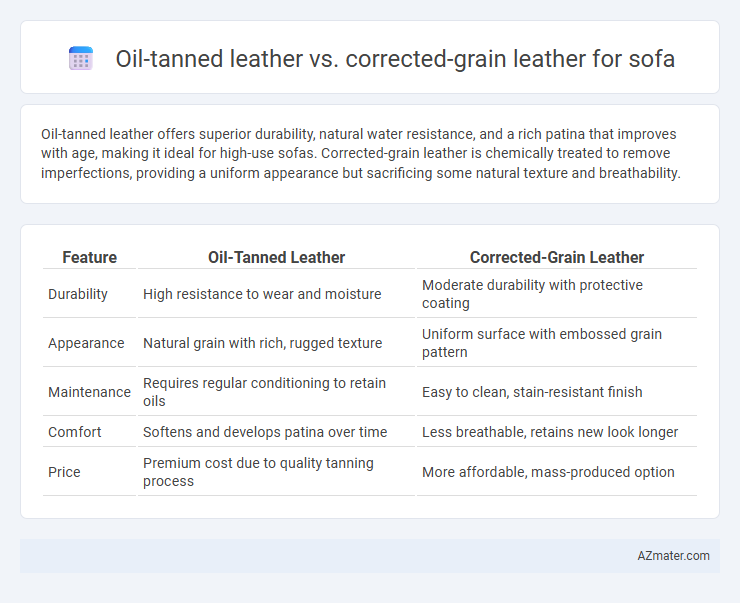Oil-tanned leather offers superior durability, natural water resistance, and a rich patina that improves with age, making it ideal for high-use sofas. Corrected-grain leather is chemically treated to remove imperfections, providing a uniform appearance but sacrificing some natural texture and breathability.
Table of Comparison
| Feature | Oil-Tanned Leather | Corrected-Grain Leather |
|---|---|---|
| Durability | High resistance to wear and moisture | Moderate durability with protective coating |
| Appearance | Natural grain with rich, rugged texture | Uniform surface with embossed grain pattern |
| Maintenance | Requires regular conditioning to retain oils | Easy to clean, stain-resistant finish |
| Comfort | Softens and develops patina over time | Less breathable, retains new look longer |
| Price | Premium cost due to quality tanning process | More affordable, mass-produced option |
Understanding Oil-Tanned Leather
Oil-tanned leather, characterized by its deeply infused oils and waxes, offers superior water resistance and a rich, supple texture that softens with age, making it ideal for durable and luxurious sofas. Unlike corrected-grain leather, which undergoes heavy sanding and coatings to mask imperfections, oil-tanned leather retains its natural grain and unique markings, enhancing the sofa's aesthetic with a robust patina over time. Its breathable and flexible properties contribute to long-lasting comfort and resilience, perfect for high-use furniture requiring both style and durability.
What Is Corrected-Grain Leather?
Corrected-grain leather is a type of leather commonly used in sofas, where the natural surface is sanded or buffed to remove imperfections before being coated with a synthetic layer to create a uniform appearance. Oil-tanned leather preserves more of the natural grain and develops a rich patina over time, offering greater durability and a softer feel compared to corrected-grain leather's more consistent but less breathable finish. Choosing between oil-tanned and corrected-grain leather depends on the desired balance of aesthetic appeal, texture, longevity, and maintenance for sofa upholstery.
Appearance: Natural vs. Processed Finishes
Oil-tanned leather exhibits a rich, natural appearance with visible imperfections and a supple texture, reflecting the animal's original characteristics. Corrected-grain leather features a uniform, processed finish achieved by sanding and embossing to mask imperfections, resulting in a consistent and polished look. The choice between the two impacts the sofa's aesthetic, with oil-tanned leather offering authenticity and warmth, while corrected-grain leather provides durability and a sleek, refined surface.
Durability and Longevity Comparison
Oil-tanned leather offers superior durability and longevity for sofas due to its natural oils that enhance resistance to wear, moisture, and cracking over time. Corrected-grain leather undergoes extensive sanding and finishing processes that improve uniformity but reduce the natural toughness and can wear down faster with heavy use. Choosing oil-tanned leather ensures a sofa that maintains its strength and appearance longer, especially in high-traffic environments.
Comfort and Feel on Sofas
Oil-tanned leather offers a supple, rich texture that improves with age, providing a comfortable, natural feel ideal for sofas designed for relaxation. Corrected-grain leather has a more uniform surface, often coated for durability, which can feel less soft and breathable but resists stains and wear effectively. When prioritizing comfort and tactile experience, oil-tanned leather tends to deliver a more luxurious and cozy seating option compared to the firmer, less forgiving corrected-grain leather.
Stain and Scratch Resistance
Oil-tanned leather offers superior stain and scratch resistance due to its dense fiber structure and natural oils that create a durable, water-repellent surface ideal for sofas. Corrected-grain leather, treated with a protective coating and embossed texture, provides decent resistance but is more susceptible to surface scratches and stains over time. For long-lasting sofa upholstery, oil-tanned leather ensures better protection against everyday wear and spills compared to corrected-grain leather.
Maintenance and Care Requirements
Oil-tanned leather requires regular conditioning to maintain its natural oils, preventing it from drying out and cracking, while also needing gentle cleaning with a damp cloth to preserve its rich patina. Corrected-grain leather, often treated with a surface finish, is more resistant to stains and easier to clean with mild soap and water but may require less frequent conditioning due to its protective coating. Both types benefit from avoiding direct sunlight and heat sources to prevent fading and drying.
Cost Differences: Oil-Tanned vs. Corrected-Grain
Oil-tanned leather typically incurs higher costs than corrected-grain leather due to its intricate processing, natural finish, and durability that enhance sofa longevity. Corrected-grain leather, being more heavily processed and embossed to conceal imperfections, offers a budget-friendly option with a uniform appearance but reduced natural texture. Consumers prioritizing long-term value often favor oil-tanned leather despite its premium price point, whereas those seeking affordability lean towards corrected-grain varieties.
Eco-Friendliness and Sustainability
Oil-tanned leather, known for its durable and water-resistant properties, undergoes minimal chemical processing, making it a more eco-friendly choice compared to corrected-grain leather, which involves heavy sanding and chemical treatments to create a uniform surface. The natural finishing of oil-tanned leather reduces the environmental impact by preserving the hide's original fibers and requiring fewer synthetic coatings. Corrected-grain leather often consumes more resources and produces more waste during manufacturing, making oil-tanned leather a more sustainable option for sofas aiming to minimize ecological footprints.
Choosing the Right Leather for Your Sofa
Oil-tanned leather offers a rich, natural finish with enhanced durability and a supple texture that matures beautifully over time, making it ideal for high-use sofas requiring longevity and character. Corrected-grain leather provides a more uniform appearance by sanding and embossing the surface, offering greater stain resistance and affordability, though it lacks the distinct natural markings of oil-tanned leather. Selecting between oil-tanned and corrected-grain leather depends on whether you prioritize authentic texture and aging qualities or consistent appearance and easier maintenance for your sofa.

Infographic: Oil-tanned leather vs Corrected-grain leather for Sofa
 azmater.com
azmater.com